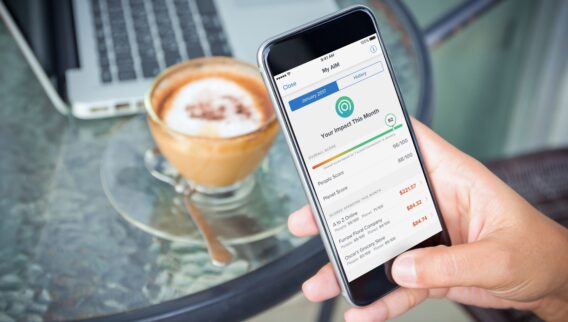You may have a debit card in your wallet, but have you ever stopped to think about how it works?
Debit cards blend the basic functions of an ATM card and a credit card to help consumers quickly access cash from their bank accounts. You can use a debit card for online purchases, at the cash register or even in a mobile wallet app to pay instead of writing a check.
What Is a Debit Card?
Debit cards are issued by your bank and work as a combination ATM card and credit card. However, unlike a credit card, a debit card links directly to your bank account, using the money you have on deposit to pay for your purchase or make your ATM withdrawal digitally.
How Does a Debit Card Work?
Debit cards partner with major credit card brands, such as VISA, Mastercard and Discover, to allow you to use your debit card for payment anywhere those branded cards are accepted.
When using your debit card for an in-person purchase, you’ll swipe, insert or use contactless pay at the card terminal just like a credit card. You’ll then enter your personal identification number (PIN) into the machine, although some merchants allow you to use your debit card without a PIN. Your PIN is a security measure that verifies your identity.
Once your bank verifies you have the money to make the purchase, your transaction is approved. If you look at your bank statement, you might see that your purchase is pending, which means your bank hasn’t yet transferred the money to the merchant, even though they’ve debited your account. When the bank sends the money to the merchant, your transaction will appear approved.
When you use your debit card to pay for a purchase or get money from an ATM, you can complete the transaction because you already have the money necessary in your linked account.
Depending on your bank, you may be allowed to overdraft your account by a certain number of dollars if you have the additional funds available in a backup account, like a savings account. But, as a rule, to spend money using your debit card, the money you need must be in your account.
Types of Debit Cards
There are four main types of debit cards. The key difference between the types is generally the entity issuing the card.
- Regular debit cards. These are issued by your bank or credit union and are tied to a checking or money market account. They typically carry a VISA, Mastercard or Discover logo and can be used for purchases in-person or online. You can also use this card type to make deposits and withdrawals from your account at ATMs.
- ATM cards. Like regular debit cards, ATM cards are also issued by your bank and tied to specific bank accounts. However, they’re only used to get cash back or, in some cases, make deposits at ATMs. They can’t be used for making purchases online or in-store.
- Prepaid debit cards. A prepaid debit card is tied to a bank account you own but not issued by that bank. Instead, these cards need to be loaded with funds before they can be used. Most cards can be used the same way a regular debit card is used, but some have fees for various services.
- Electronic Benefits Transfer (EBT) Cards. Government agencies issue these debit cards to provide social benefits to cardholders. Programs like nutritional assistance pay out their benefits monthly to the card balance. Cardholders can then use the card to pay for approved purchases at merchants that accept EBT cards.
How to Get a Debit Card
Financial institutions often issue debit cards automatically when you open a checking account, but you may need to request one. After receiving the card, you’ll activate it according to the instructions that come along with the card.
During the activation process, you’ll set your PIN. You’ll use your PIN for point-of-sale purchases, anytime you request cash back during a purchase and when withdrawing money from an ATM.
If you don’t have a bank account, you can get a prepaid debit card through several online services like Netspend. Retailers like Walmart also offer their prepaid debit card brands, as do major credit card companies like VISA, Mastercard and American Express.
If you choose to use a prepaid debit card, though, be aware that some charge monthly fees that can cut into your deposits.
How Old Do You Have To Be To Get a Debit Card?
It’s important to note that each bank sets minimum age limits for debit card eligibility. However, depending on the bank and account type, there are options to have a debit card issued to those as young as 13. These accounts are commonly labeled as teen checking accounts and require a parent or guardian as a joint account holder.
Once someone turns 18, they’re legally eligible to open a bank account in their name without a joint account holder.
Debit Card Fees
Debit cards won’t typically have fees for everyday use, but there are fees in some cases:
- Overdraft fees. If you overdraft your account with a purchase, you may incur a fee.
- ATM fees. Many banks don’t charge for in-network ATM withdrawals. If you use an ATM that isn’t in your bank’s network, you’ll be advised of any fees that may apply before completing your transaction.
- Account holds. If you use your debit card to rent a hotel room or car, you may have a hold placed on your card for more than the value of your transaction. This hold will decrease your available account balance until the hold falls off your account.
Credit Card vs. Debit Card
Debit cards differ from credit cards in a few ways.
Credit cards grant you an available credit line to make purchases. You can pay back the amount of your credit line that you use over time in monthly payments. The credit card company will charge you interest on your balance in exchange for taking on the risk of your purchases.
A debit card isn’t a credit line. Instead, it uses the money you have on deposit in the bank to pay merchants for goods and services or issue you cash from an ATM.
Prepaid Card vs. Debit Card
Two types of cards have names that are similar enough to confuse some consumers:
- A traditional debit card is issued by your bank and directly connects to your checking account, using funds you put in the bank to pay for ATM withdrawals and card purchases.
- With a prepaid debit card, also known as a prepaid card, you have to load funds on the card before using it (as you do when purchasing a gift card). You can use cash, electronic transfers or checks to add funds to your card. You can load funds either online or by visiting a retailer that supports the prepaid card.
Frequently, those without access to banking services use prepaid debit cards to receive funds and spend money. Some employers issue paychecks through prepaid debit cards. Some cities even issue government benefits like unemployment or food assistance funds through prepaid cards. Even the recent COVID-19 stimulus payments used prepaid cards to issue several million payments.
ATM Card vs. Debit Card
While both debit cards and ATM cards allow you to access funds in your checking account, you can’t use an ATM card to make purchases.
ATM card use is strictly limited to transactions at an ATM.
How to Handle a Lost or Stolen Debit Card
First, don’t panic. Cards get lost and stolen every day. Contact your bank as soon as possible and let them know what’s happened to your card. Some banks even allow you to report this online through their online banking portal, while others require that you call.
Sometimes the bank will freeze your card, just in case you find it. Other times, the bank will immediately deactivate that debit card and send you a new debit card.
If your card is lost or stolen, it’s essential to report it promptly to reduce your liability for fraudulent charges. If you report your card lost or stolen within two days, you’ll only be liable for a maximum of $50 in unauthorized charges (and some banks waive that fee as a courtesy). Your liability rises to $500 if you don’t report your card lost or stolen until after two days but before 60 days after your statement is sent.
Debit Card Advantages and Disadvantages
Debit cards are, without a doubt, powerful financial tools but aren’t without their drawbacks. It’s important to understand the pros and cons of these cards so you can develop smart financial habits and use them wisely.
Debit Card Advantages:
- No annual fees. Unlike some credit cards, debit cards issued by your bank or credit union are free of annual fees.
- Convenience. Debit cards can be used at millions of stores, online merchants and ATMs. They can even be added to digital wallets.
- Budgeting. Instead of running up a credit card balance, debit cards let you pay with cash and help you prevent spending beyond your budget.
Debit Card Disadvantages:
- They aren’t fee-free. Prepaid debit cards often have monthly maintenance fees. If you overspend, your bank will likely charge you an overdraft fee. And don’t forget about ATM fees if you don’t use an ATM in your bank’s network.
- Often better for small purchases. Debit cards make grocery trips a breeze, but that flat-screen TV could take a big chunk out of your bank account.
- Could lead to overspending. The convenience of a debit card can lead to swiping without thinking about your available balance, taking a bite out of your well-planned budget.
Find The Best Online Banks Of 2025
Bottom Line
Debit cards give you the flexibility of paying with a card instead of writing a check, both online and in person. It’s important to match the cards in your wallet with your spending habits, so take some time to compare your various spending options like credit cards, debit cards and prepaid cards. A combination of the three can help you gain the flexibility you crave with the seamless access to cash your daily activities require.
Frequently Asked Questions (FAQs)
How do I check my debit card balance?
Only prepaid debit cards have balances and you can check your available spending balance through the card issuer’s website or by phone. Generally, your debit card is connected to your checking or money market account, which is your available balance.
How long does it take for a refund to go back to your debit card?
Debit card refunds may take anywhere from three to 10 days from the date the refund is made. Processing time may vary, depending on the merchant, your bank, and the transaction amount.
How do I cancel all subscriptions on my debit card?
To cancel subscriptions and recurring payments, review your bank statement for any recurring purchases, then go directly to the merchant to cancel your subscription.
Where is the routing number on a debit card?
There is no routing number on your debit card. Your card is assigned a unique card number and your card is linked to your bank account.
How do I dispute a charge on a debit card?
You can call your bank or use your online banking portal to dispute a charge.








